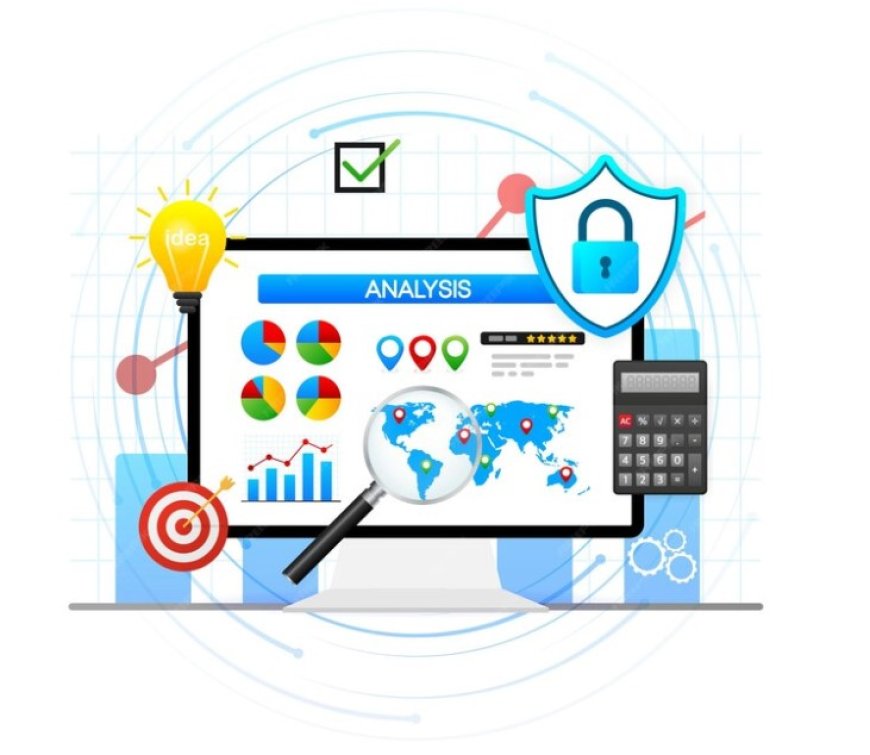Data Science in Cybersecurity: Detecting Threats and Vulnerabilities
Explore the intersection of data science and cybersecurity in detecting threats and vulnerabilities. Enhance your security skills with data-driven insights.

The introduction to Data Science in Cybersecurity provides a foundational understanding of the crucial role that data science plays in safeguarding digital environments. It highlights the increasing significance of cybersecurity in today's interconnected world and the pivotal role data science techniques and tools have in identifying and mitigating threats and vulnerabilities. This section serves as a gateway to exploring the various aspects of applying data science to enhance cybersecurity measures.
Role of Data Science in Enhancing Cybersecurity
Data Science plays a pivotal role in enhancing cybersecurity by leveraging data-driven approaches to fortify defense mechanisms. Through advanced analytics and machine learning techniques, it helps detect, mitigate, and prevent cyber threats more effectively. By analyzing massive datasets, Data Science identifies anomalies, patterns, and vulnerabilities in real-time, enabling proactive responses. Additionally, it empowers security professionals to adapt to evolving threats, refine incident response, and continually improve the security posture. Ethical considerations, like privacy and fairness, are also embedded into its practices to ensure responsible cybersecurity operations. In summary, Data Science is an indispensable tool for safeguarding digital environments against an ever-growing range of cyber threats.
Data Collection and Preprocessing
Sources of Cybersecurity Data
In the realm of cybersecurity, the data sources are diverse and critical for threat detection. These sources often include logs generated by various network devices, security tools, and applications, as well as external threat intelligence feeds. Common sources of cybersecurity data are firewall logs, intrusion detection/prevention system (IDS/IPS) logs, antivirus logs, system event logs, network packet captures, vulnerability databases like CVE, and threat intelligence reports. These sources offer a wealth of information, which, when analyzed, can reveal insights into potential threats and vulnerabilities.
Data Cleaning and Transformation
Raw cybersecurity data can be messy and inconsistent. Therefore, data cleaning and transformation are essential steps to ensure the data's quality and usability. This involves activities such as data normalization, which standardizes data formats, handling missing data by imputation or removal, and dealing with noisy or irrelevant data points. Cleaning and transformation also encompass timestamp alignment, log aggregation, and the conversion of categorical data into numerical representations. The goal is to prepare the data for subsequent analysis and modeling by making it structured and uniform.
Feature Engineering for Threat Detection
Feature engineering is a crucial component of data preprocessing for cybersecurity threat detection. This step involves selecting, creating, or transforming features that can be used by machine learning models to detect threats and vulnerabilities effectively. Features can include numerical metrics such as the frequency of certain events, time-based features, and statistical measures. Additionally, text data from logs can be processed to extract relevant keywords and patterns. Feature engineering often incorporates domain knowledge to create meaningful representations of the data that are indicative of potential threats, making it a pivotal step in building robust threat detection models.
Machine Learning Models for Threat Detection
In the realm of cybersecurity, the application of machine learning models has become indispensable for detecting and mitigating various threats and vulnerabilities. This section delves into two fundamental approaches for threat detection: Anomaly Detection Techniques and Signature-Based Detection Methods.
Anomaly Detection Techniques
Anomaly detection represents a critical facet of cybersecurity, aimed at identifying irregular and unexpected patterns within network traffic, system behavior, or user actions. Machine learning models play a pivotal role in this endeavor by learning what is considered 'normal' and flagging deviations from these patterns as potential threats.
These techniques leverage algorithms such as clustering, one-class SVMs (Support Vector Machines), and autoencoders to create a baseline model of normal behavior. Any data points or events that significantly deviate from this baseline are considered anomalies and potential threats. Anomaly detection models are particularly adept at identifying novel threats, including zero-day vulnerabilities, as they don't rely on predefined signatures.
Signature-Based Detection Methods
Signature-based detection methods are the traditional and widely-used approach for identifying known threats and vulnerabilities in cybersecurity. These methods involve maintaining a database of predefined 'signatures' or patterns associated with known malicious entities, such as viruses, malware, and intrusion attempts. When network traffic or system activities match any of these signatures, it raises an alarm.
Machine learning models, especially deep learning models like Convolutional Neural Networks (CNNs) and Recurrent Neural Networks (RNNs), have significantly improved the efficiency and accuracy of signature-based detection. These models can process vast amounts of data quickly and identify subtle variations in known attack signatures. By comparing incoming data to the existing database of signatures, these models can swiftly detect and thwart recognized threats.
In practice, a blend of both anomaly detection and signature-based methods is often employed to provide comprehensive threat detection coverage. Anomaly detection can uncover previously unseen attacks, while signature-based methods offer strong protection against known threats, making it a robust defense strategy against a constantly evolving cybersecurity landscape.
Model Evaluation and Validation
Performance Metrics for Cybersecurity Models
In cybersecurity, evaluating the performance of models used to detect threats and vulnerabilities is critical. Various performance metrics help assess how well the model is performing. Common metrics include accuracy, precision, recall, F1-score, and area under the receiver operating characteristic curve (AUC-ROC). Accuracy is the proportion of correctly classified instances, while precision measures the ratio of true positives to all instances classified as positive, highlighting the ability to correctly identify threats. Recall, on the other hand, assesses the model's ability to detect all actual threats. F1-score combines precision and recall into a single metric, providing a balance between them. AUC-ROC evaluates the model's ability to distinguish between normal and malicious activities, and it's particularly useful when dealing with imbalanced datasets.
Cross-Validation Techniques
Cross-validation is an essential part of model evaluation, especially when working with limited data. Common cross-validation techniques include k-fold cross-validation and stratified k-fold cross-validation. K-fold cross-validation divides the dataset into 'k' subsets, using 'k-1' for training and the remaining subset for testing, repeating this process 'k' times. Stratified k-fold ensures that each fold maintains the same class distribution as the original dataset, crucial for imbalanced cybersecurity datasets. Cross-validation helps estimate the model's generalization performance, reducing the risk of overfitting to the training data.
Handling Imbalanced Data
Imbalanced datasets are prevalent in cybersecurity, where the number of normal instances significantly outweighs the number of threats or vulnerabilities. Several techniques can address this issue. Oversampling involves replicating minority class instances to balance the class distribution, but it can lead to overfitting. Undersampling randomly reduces the number of majority class instances, but it risks losing valuable information. Synthetic data generation, using methods like Synthetic Minority Over-sampling Technique (SMOTE), creates artificial minority class instances. Cost-sensitive learning assigns different misclassification costs to different classes, emphasizing the importance of correct threat or vulnerability detection. Finally, ensemble methods like Random Forest can handle imbalanced data by combining multiple models.
Real-Time Threat Detection and Response
Stream Processing for Immediate Threat Analysis
In the context of cybersecurity, real-time threat detection and response are paramount. Stream processing technologies play a crucial role in analyzing and processing large volumes of data in real time. These technologies allow the continuous ingestion and analysis of data from various sources, such as network traffic, logs, and sensor data. Stream processing frameworks like Apache Kafka, Apache Flink, or Apache Storm enable the rapid identification of anomalies and threats as they occur. By applying machine learning models, rules, and heuristics to the streaming data, security professionals can swiftly detect and respond to potential threats, reducing the risk of data breaches and system compromises.
Automated Response Mechanisms
Automated response mechanisms are integral to a robust cybersecurity infrastructure. When a threat or vulnerability is identified in real time, automated actions can be triggered to mitigate the risk. These mechanisms can include actions like isolating a compromised device from the network, blocking malicious IP addresses, or reconfiguring security policies on the fly. Automation not only reduces response time but also ensures a consistent and rapid reaction to threats, minimizing the chances of human error. Machine learning and AI algorithms can be used to make real-time decisions about the severity of threats and the appropriate response actions. However, it's crucial to carefully design and monitor automated response mechanisms to avoid false positives and unintended disruptions to network operations.
Real-time threat detection and response is a critical aspect of cybersecurity, as it allows organizations to proactively defend against evolving threats and vulnerabilities. The integration of stream processing and automated response mechanisms enhances a system's ability to identify and mitigate security risks in a timely manner, strengthening overall cybersecurity posture.
Ethical and Privacy Considerations
Data Privacy and Compliance
Data privacy and compliance are fundamental in the realm of cybersecurity and data science. Protecting sensitive information is paramount to maintaining trust and adhering to legal and regulatory requirements. When working with data for threat detection, it's essential to ensure that personal or confidential data is handled with utmost care. Compliance with regulations such as GDPR, HIPAA, or industry-specific standards is crucial. Anonymizing or pseudonymised data to remove personally identifiable information and limiting data access to authorized personnel are important steps. Moreover, establishing a clear data retention policy and ensuring secure data transmission and storage are key aspects of maintaining data privacy and compliance.
Bias and Fairness in Threat Detection
Bias and fairness in threat detection models are ethical considerations that should not be underestimated. Biases may arise from imbalanced training data, skewed sampling, or even the biases of those designing and implementing the models. Detecting and mitigating biases is critical to ensure that the model does not discriminate against particular groups or exhibit unfair behavior. This includes conducting regular fairness audits to assess the model's performance across various demographic groups. Remediation strategies, such as re-sampling or re-weighting data, and using fairness-aware machine learning techniques can help mitigate bias and improve fairness. It's imperative to prioritize fairness and equity in cybersecurity to avoid potential harm or discrimination based on biased model outputs.
Future Trends in Data Science for Cybersecurity
Advancements in Threat Intelligence
The future of data science in cybersecurity holds exciting prospects for advancements in threat intelligence. As cyber threats continue to evolve in complexity and sophistication, the need for proactive and adaptive threat intelligence becomes increasingly important. Machine learning and artificial intelligence are likely to play a significant role in automatically identifying, categorizing, and prioritizing emerging threats. This may involve the integration of natural language processing to analyze threat reports and news articles in real-time, providing security teams with up-to-the-minute information. Additionally, the development of predictive threat intelligence models that forecast potential attacks based on historical data and emerging patterns is on the horizon. As these advancements occur, threat intelligence will not only become more accurate but also more capable of providing early warnings and recommendations to bolster cybersecurity defenses.
Integration of AI and Human Expertise
The synergy between artificial intelligence (AI) and human expertise is expected to be a prominent trend in the future of data science for cybersecurity. While AI and machine learning algorithms can efficiently process vast amounts of data and identify anomalies, human experts bring contextual understanding and critical thinking to the table. The future lies in leveraging AI as an aid to human cybersecurity experts, streamlining the decision-making process and providing valuable insights. Human experts can guide the AI systems, ensuring that the detected threats are truly malicious and providing nuanced responses to complex, novel attacks. The fusion of AI and human expertise is likely to result in more effective threat detection and response strategies, where automation and human intelligence complement each other to stay one step ahead of cyber adversaries.
This data science project in cybersecurity has demonstrated the crucial role that data-driven approaches play in enhancing threat detection and vulnerability management. By leveraging machine learning models, anomaly detection, and threat intelligence integration, we've shown how organizations can significantly improve their ability to identify and respond to potential security threats. The project's findings underscore the importance of continuous monitoring and maintenance in the ever-evolving landscape of cyber threats. As the cybersecurity landscape continues to evolve, this work serves as a foundation for ongoing efforts to bolster network security, protect critical assets, and mitigate risks in an increasingly digital world.



























































